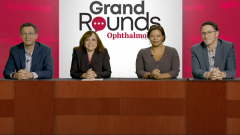
Case 3: nAMD in a Patient With Geographic Atrophy
Roger Goldberg, MD, presents a case of a patient showing signs of geographic atrophy who subsequently develops nAMD and highlights the favorable outcomes achieved through anti-VEGF therapy.
Arghavan Almony, MD: We’ll move to our third case. Roger, if you could.
Roger Goldberg, MD: I’m pleased to be sharing a case from my good friend and colleague Nate Steinle[, MD] down in Santa Barbara, [California]. This is a patient of his whom he refers to as one of his true VIP patients. [This is] a 71-year-old [woman] with slow-onset blurred vision in both eyes. Here’s the color fundus photo of the right eye, and we see a little bit of [geographic] atrophy present and drusen. Here’s a baseline angiogram, [and there is] no leakage present. Here’s the OCT [optical coherence tomography], where we see drusen in areas of atrophy, again, in the right eye. Here’s the left eye, [with] intermediate AMD [age-related macular degeneration]. [There is a lot] of drusen [but] no significant atrophy seen on the fundus autofluorescence [and] no leakage on the angiogram. Here we see the drusen present and maybe areas of early atrophy, but diagnosed with dry AMD with focal areas of GA [geographic atrophy]. [The] patient is [presenting with] increasing problems with their vision, is diagnosed with cataracts, and undergoes bilateral, uneventful cataract surgery. [The] patient travels to Europe and says [their] vision is great, but 4 months later, [they have] blurred vision in both eyes. Is there a PCO [posterior capsule opacification] present? Nope—no PCO found in either eye. So, what’s happened here?
Let’s take a look at the retina. Here we see leakage on the FA [fluorescein angiogram] in the right eye, and we had a good baseline from earlier. We see a small, superior macular hemorrhage in the right eye. We see that blockage present on the FA. Here’s new leakage on the FA in the left eye. I think we’ll see the OCTs momentarily here, but we see subretinal hyperreflective material [SHRM] in the right eye adjacent to the areas of [geographic] atrophy but suggestive of leakage where that hemorrhage is present. In the left eye, there’s SHRM, intraretinal fluid, and an enlarged PED.
[This is] new onset bilateral wet AMD in his VIP patient, who is a family member. He decides to treat this patient with faricimab. The patient returned in 1 month and fluid is resolved in the right eye. Here you can see the scan, and there’s total resolution of that hemorrhage, which showed up as the SHRM. Fluid is [also] resolved in the left [eye]. [There’s no] intraretinal fluid, [and] that SHRM has resolved as well. [The patient] still has the areas of atrophy. And so the patient is treated with a treat-and-extend regimen and is currently extended out to a 10-week interval on faricimab in both eyes.
Here’s how the patient looks after 6 months of treatment. Hemorrhage is resolved, still has areas of atrophy present—some just adjacent to the fovea—and still a relatively small burden of [geographic] atrophy but great control of their exudative AMD. So, I think this is a great case of a patient who’s done beautifully—a patient [who] he cares deeply about. The patient’s vision is now 20/25 in both eyes. As we have these next-generation agents…I think a lot of us felt comfortable extending patients out to a 3-month interval. We know in the pivotal studies for faricimab, patients were extended out to 4 months, so it gives you the opportunity to extend out even longer than what we had been doing in the past. This patient had a great outcome. [The] patient also has GA, [so we’re] thinking about: Are we treating this patient with one of the anticomplement agents, in addition to an anti-VEGF? In this case, the patient’s being treated with faricimab. [This is a] great case; I appreciate Dr Steinle for sharing it with us.
Transcript is AI generated and edited for clarity and readability.
Newsletter
Don’t miss out—get Ophthalmology Times updates on the latest clinical advancements and expert interviews, straight to your inbox.














































